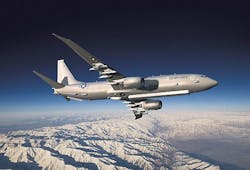Raytheon to develop open-systems airborne electronic warfare (EW) system to counter enemy radar
WRIGHT-PATTERSON AFB, Ohio – U.S. Air Force researchers are asking the Raytheon Co. to design an experimental open-systems airborne electronic warfare (EW) system that can provide enhanced capability against current and emerging RF threats like advanced enemy radar.
Officials of the Air Force Research Laboratory at Wright-Patterson Air Force Base, Ohio, announced a $3.1 million contract Tuesday to the Raytheon Space and Airborne Systems segment in Goleta, Calif., for the Electronic Support Critical Experiment (ESCE) project.
ESCE has three main parts: defining an EW receiver architecture: demonstrating key signal-processing functions; and assessing key enabling technologies.
Raytheon experts will define a functional decomposition of an innovative EW receiver architecture that will provide enhanced capability against current and emerging RF threats in relevant background environments.
The architecture should provide a scalable and open-systems design that lends itself to adding, upgrading, or replacing existing hardware, firmware, and software without any significant system redesign. The architecture also should be able to easily expand and grow as the threat evolves.
Related: BAE Systems to develop advanced electronic warfare (EW) to counter enemy programmable radar
Raytheon also will demonstrate key signal-processing functions in the proposed architecture. Signal processing encompasses all aspects of signal detection, emitter parameter measurement and correlation, emitter sorting, and identification.
The company also will perform government assessments to document key signal-processing capabilities and assess key technologies. To do this, the Air Force will provide RF environments that progressively increase in complexity to assess signal processing functions. These signal-processing functions should produce a signal emitter report for each emitter in all environments.
Air Force researchers say they expect to award as many as two ESCE contracts, so additional companies may get involved with this project. Total program cost will be about $6.2 million.
For more information contact Raytheon Space and Airborne Systems online at www.raytheon.com/capabilities/ew, or the Air Force Research Laboratory at www.wpafb.af.mil/afrl.
Learn more: search the Aerospace & Defense Buyer's Guide for companies, new products, press releases, and videos

